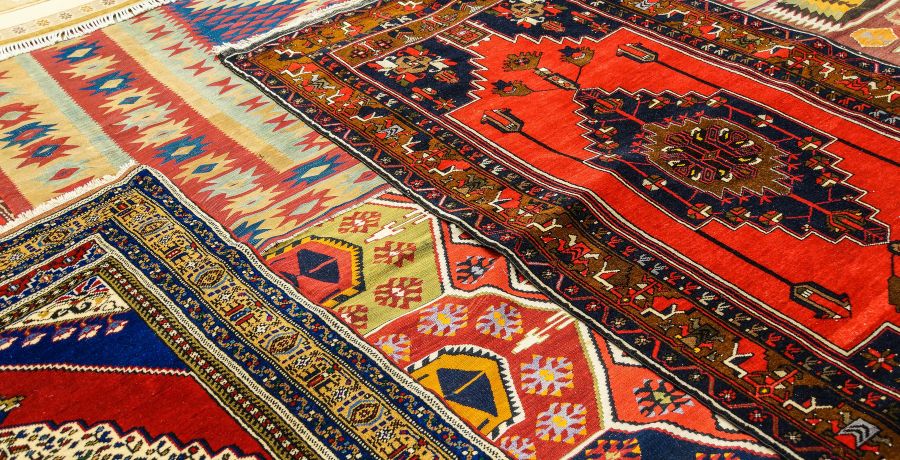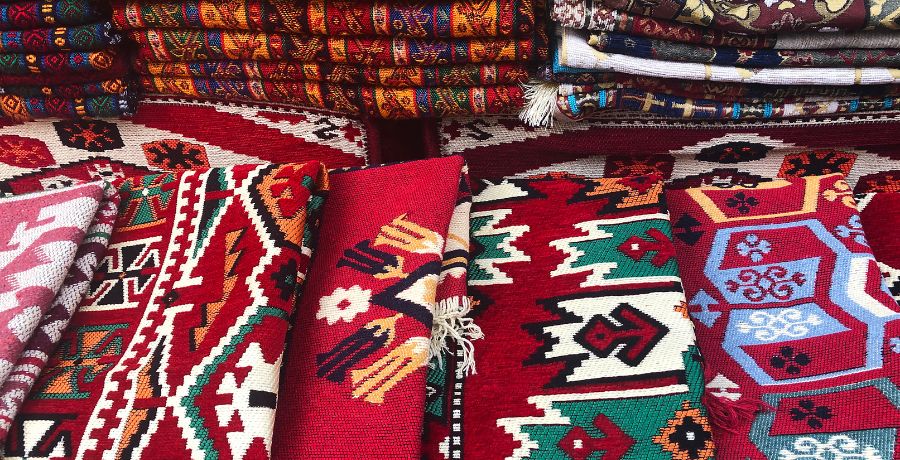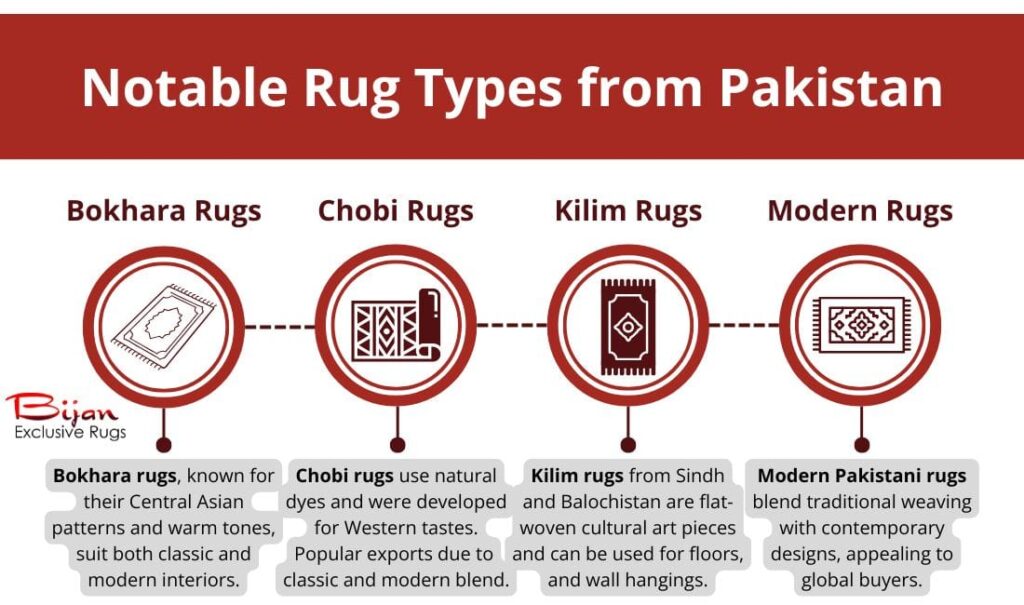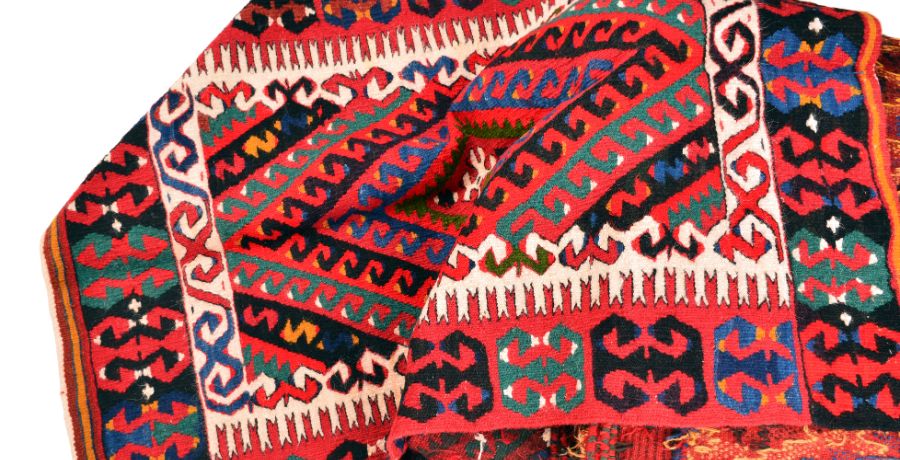
Pakistani rugs are renowned around the world, particularly due to their highly detailed patterns and exceptional workmanship. The worldwide popularity of Pakistani rugs continues to increase as they are valued not only as art pieces of great aesthetic beauty but also as cultural heritage products.
Knowledge on the history and origin of the Pakistani rugs adds meaning to every piece. The rugs are not mere decorations but also woven narratives of being a migrant, an empire, resilience, and identity.
➜ Related: History and Origins of Bijar Rugs
Ancient Roots and Early Influences
The history of Pakistani rugs dates back to the broader customs of carpet-making in South Asia, long before the creation of Pakistan in 1947. The multicultural area that currently constitutes Pakistan has long been a crossroads of cultures that have influenced each other across centuries, and their customs of making rugs have a series of layers of artistic, social, as well as economic impact.
Carpet-Making in South Asia Before Pakistan’s Formation
Although Pakistan is a relatively young country, the history of Pakistani rugs dates back very deep into ancient history; the archaeological record and written records point to the existence of textile and fibre work (even the beginning forms of rug weaving) in ancient societies of the region.
Impact of Silk Road Trade on Weaving Traditions
The Silk Road, which traversed through what is now Pakistan, was very important in influencing the history of rug weaving in Pakistan. These Trading Routes united Artisans and Merchants around Central Asia, Persia, China, and the Indian subcontinent.
Along these routes, not only goods but also procedures, equipment, and even aesthetic sensibilities were transported.
Central Asian and Persian textile and rug-making practices, especially Persian knotting techniques and dyeing techniques influenced local artisans permanently.
This mixture of indigenous skills and foreign technologies facilitated the formation of unique, heavily decorated tribal-looking rugs that would later be recognised as Pakistani rugs.
The Mughal Era: The Golden Age of Carpet Weaving
A crucial point in Pakistani rug history is the Mughal period, often referred to as the golden age of rug weaving in the Indian subcontinent.
It was at this time that the rug-making tradition in the region was revolutionised from a local industry to an art form, thanks to the Mughal emperors, who had a great affinity for Persian culture.
During the Mughal Empire’s reign, the rug industry was heavily influenced by royal patronage. The emperors had established state-sponsored carpet workshops. Lahore was one of the major centres of rug weaving activities in Pakistan.
These were professional workshops that specialised in the skilled hands of finer artisans, as they were expected to create luxurious, hand-knotted rugs for use in palaces, mosques, and designated high-profile homes.

Regional Diversity in Pakistani Rugs
The country’s great regional diversity highly influences the origins and history of Pakistani rugs. In Pakistan, each province has its own weaving style, design theme, and material, contributing to the national rug-weaving tradition.
This variety depicts the centuries of cultures exchanged, migration and, of course, craftsmanship.
Punjab
Lahore is recognised to have a long history of rug weaving which dates back to the Mughal period. The weaving workshops of Lahore were known to produce court-style rugs; extremely ornamental and luxurious rugs with their designs being influenced by the Persian and Mughal designs.
These rugs are characterised by:
- Motifs that are floral and medallion
- Close knotting and tight detailing
- The natural dyes and hand spun wool or silk
- Symmetrical designs which were appropriate in palaces, courts, and formal interiors
Today, Lahore rugs remain an important component of Pakistan’s rug export industry, valued for their artwork and ancient tradition.
Balochistan
Balochistan rugs have a tribal and nomadic background in contrast to the smooth and sophisticated court rugs of Punjab. These rugs are made by Baloch tribes and by other ethnic groups inhabiting the region in small, family-based, non-loomed environments that do not maintain official workshops.
Key characteristics of Balochi rugs include:
- Bold, geometric patterns
- Subdued colours in earth-toned hues
- Coarser handspun wool, which was much commoner in towns than in the countryside
- Smaller, easily transportable sizes of rugs appropriate to the nomadic life
They are genuine and rustic tribal Pakistani rugs, typically collected due to their unusual symbolism and age.
Khyber Pakhtunkhwa
Khyber Pakhtunkhwa (KPK) province is affiliated with Afghan refugee artisans who arrived in the region as the result of the Soviet-Afghan War.
The result of these communities was a centuries-old weaving practice that influenced the Pakistani Bokhara rug, as well as other Pakistani styles that have emerged.
Defining features of rugs from KPK include:
- Stretching gul patterns which are common in Bokhara rugs
- Representation of geometry and symmetry
- Use deep reds, blues, and even ivory colour palette.
- It is made by use of fine wool and hand-knotting in the traditional way
Sindh
Sindh has a rich and long-standing tradition in textile art. Its part in the development of Pakistani rug history lies in the creation of flatweave kilims and vegetable-dyed rugs.
The Sindhi kilims are highly coloured, lightweight, charming and culturally expressive fabrics woven by rural women using horizontal looms.
Characteristics of Sindhi rugs include:
- The deep intense colours obtained by using natural vegetable dyes
- Pile-less weaving, Flatweave (kilim)
- Tribal abstract and symbolic designs Abstract and symbolic tribal design
These Pakistani kilims are not only decorative and functional but also art pieces that meet the art and cultural needs of rural Sindh communities in their daily lives.
Evolution Post-Partition (1947 – Present)
The history of Pakistani rugs since 1947 marks a path to their rebirth, reinvention, and acceptance by the global market. The rug weaving business underwent a significant transformation after Pakistan’s establishment, shaped by political influences, migration, and growing global demand.
Pakistan had an inherited history of skilled artisans and textile traditions in its region but did not have a formal carpet industry.
Noticing the cultural and economic profitability of rug-making, the government and privately owned businesses started reintroducing and restructuring the carpet-weaving industry into a formal sector.
This revival laid the foundation for Pakistan’s emergence as a major player in the global hand-knotted rug market.
From the 1970s to the early 2000s, Pakistan experienced a boom period in carpet exports, producing some of the finest handmade rugs in the world.
The combination of Persian-like styles, along with tribal and affordable prices, contributed to the success of Pakistani carpets in North America, Europe, and the Middle East.

Iconic Pakistani Rug Styles
During the decades, Pakistani rugs have developed into a variety of styles, every one of them defined by a combination of local cultural influences and regional expertise, and commercial needs.
These are among the most popular Pakistani designs of carpet weaving, the age-old to the most modern forms of blending.
Bokhara Rugs
One of the most widely known variants of Pakistani hand-knotted rugs, the Bokhara rug is one of the most recognisable due to its unique appearance and Central Asian heritage.
Due to the effect of graceful pattern repetition and the use of a warm palette, Pakistani Bokhara rugs find their use in various interiors, both in traditional and modern styles.
Chobi Rugs
Developed in response to Western design tastes, Chobi rugs have become a significant export commodity to Pakistan. Chobi got its name from the Farsi term, which means “wood,” reflecting the use of natural vegetable dyes to create the design.
These Pakistani Chobi rugs are especially popular in Western markets due to their transitional style, which falls between classic and modern styles.
Kilim Rugs
Kilim rugs are a very significant aspect of tribal rug production in Pakistan, particularly in Sindh and Balochistan. Kilims are not piled carpets but rather flat-woven rugs, highly valued for their lightweight and robust structure, as well as their rich colours and geometrical imagery.
Kilim rugs serve as decorations not only on floors but also as wall hangings, prayer mats and cultural artefacts as old as their cultures.
Modern Fusion Rugs
Newer categories of Pakistani modern rugs have arisen in recent years and blend the traditional techniques of weaving with newer patterns and colour schemes.
These fusion carpets incorporate changing design trends while preserving the tradition of hand-knotted craftsmanship.
Interior designers and consumers around the world have favoured this type of rug because they want to achieve originality with a touch of modern look, and this has put Pakistan in the limelight as a nation that produces creative, handmade carpets.
Materials and Techniques
Pakistani rugs are not only about their designs; the quality and authenticity also depend on the materials and methods used in their making. The choice of the finest fibres, right up to the complexity of the hand-knotting, all stages of the rug-making process evidence centuries of traditions and customs transmitted through generations.
Use of Wool, Silk, and Cotton
In Pakistani rug weaving, there is a wide range of materials taken, and each material is selected due to its specific characteristics:
- The most frequently used material is wool due to its durability, softness, and dyeability. Highland and handspun wool from local sheep give many Pakistani wool rugs their dense pile and warm texture.
- Delicate carpets are sometimes made with silk added to wool or pure silk on finer grounds. Pakistani silk rugs often feature fine details and a glossy finish and can be designed to be displayed or used in areas of low to moderate traffic.
- Pakistani hand-knotted rugs often feature a cotton foundation, providing a stable and durable base.
Such natural fibres not only enhance the feel of the rugs but also make them more sustainable from an ecological perspective.
Hand-Knotting vs. Flat-Weaving
There are two primary rug-making techniques in Pakistan:
- Hand-knotting is the finest and most time-consuming method. The warp threads are bound to knots that are applied by the artisans one knot at a time, allowing for complex designs and a high level of knots in the pattern.
- Flat-weaving, as seen in Pakistani kilims, consists of interweaving weft and warp in a flat surface without a pile. The process produces a finer, reversible rug with strong graphic designs suitable to very tribal or minimalist settings.
Natural Dyes and Traditional Dyeing Techniques
The use of colour is critical in the identity of the Pakistani handwoven rugs. Natural vegetable dyes are made from plants, roots, bark, and minerals, and many traditional rugs utilise these dyes. These dyes are not only rich and earthy in look, but they age gracefully with time as well.
The dyeing process is traditionally performed by boiling, soaking, and allowing the fibres to dry in the sun, methods that have remained largely unchanged for centuries.

Challenges and Preservation Efforts
Handmade Pakistani rugs face numerous challenges in the contemporary world. With the changes in markets and the increasing pace of industrial production, the traditional system of rug-making in Pakistan is facing challenges.
However, various activities, both at the local and international levels, are aimed at preserving this cultural heritage.
Threats from Machine-Made Imitations
The emergence of machine-made rugs is one of the greatest threats to the Pakistani rug industry. The mass-produced styles of carpets are frequently imported at a low price and resemble hand-knotted Pakistani rugs in terms of appearance but do not match their durability, originality, or craftsmanship.
This has caused many master weavers to struggle, and as a consequence, traditional Pakistani rug production has declined.
Decline in Traditional Training
The other major issue is the loss of generational knowledge. In the rural villages where rug weaving was once a family tradition in Pakistan, the current younger generations are showing an inclination towards other occupations in large cities or even technologically advanced jobs.
Lacking adequate support, these ancient traditions in the production of Pakistani rugs would fade away in one generation.
Preservation Efforts in Pakistani Rug Weaving
It is essential to preserve the wonderful tradition of the Pakistani people, which includes their centuries-old traditions of weaving carpets and rugs. Against the backdrop of modernisation, the decline of traditional craftsmanship, and the scarcity of natural materials, these traditions are becoming a real priority.
A major step towards preservation is the opening of artisan cooperatives and vocational training centres, whose purpose is to pass on traditional weaving techniques to future generations.
Several NGOs, like Label Step, and cultural organisations are also now involved in preserving traditional rug patterns, recipes for natural dyes, and local weaving designs. Such documentation ensures that the information is not lost and also serves as a valuable resource for future artisans and researchers.
Such undertakings, in conjunction with policy support and community engagement, are crucial in ensuring that the cultural and artistic heritage of Pakistani rug weaving is passed on to future generations.
We Offer a Superior Collection of Genuine Pakistani Rugs
The history and origins of Pakistani rugs depict an enduring art form that has endured amidst political turmoil, economic uncertainties, and cultural changes. The Pakistani carpet has evolved but remains rooted in tradition.
Being pure representations of craftsmanship, Pakistani rugs stand out in the history of world art and design, valued for their artistic and artisanal excellence, as well as their use of narrative motifs.
Bijan’s Exclusive Rugs is committed to the same legacy and offers a superior collection of genuine Pakistani rugs and Persian rugs.
Each of the rugs we carry is a testament to heritage, value, or timeless design and is produced ethically.
Browse our collection or contact us for personalised recommendations.

